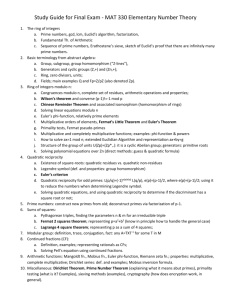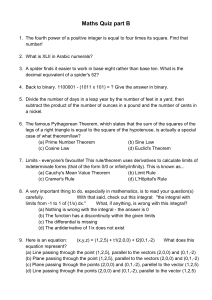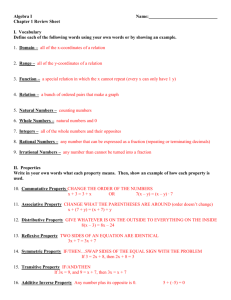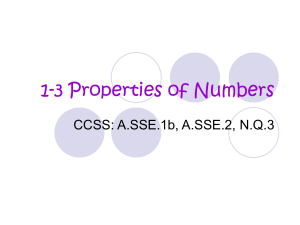Central limit theorem for random multiplicative functions
advertisement
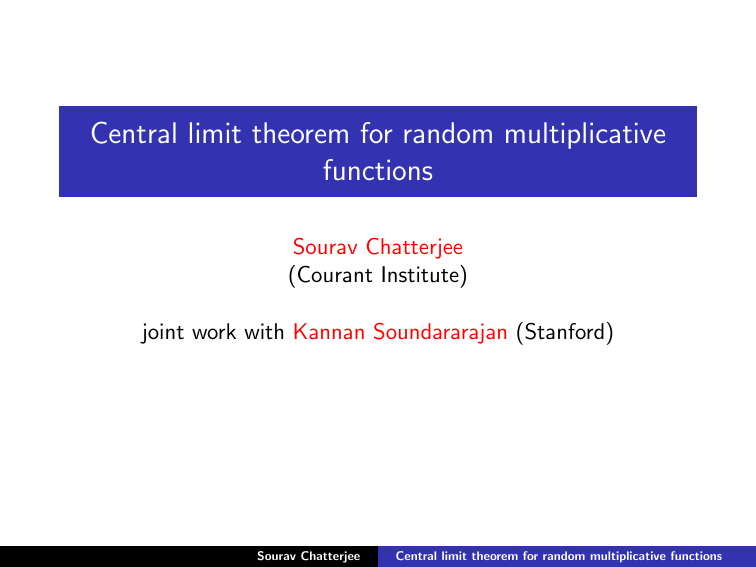
Central limit theorem for random multiplicative
functions
Sourav Chatterjee
(Courant Institute)
joint work with Kannan Soundararajan (Stanford)
Sourav Chatterjee
Central limit theorem for random multiplicative functions
Multiplicative functions
I
I
I
I
I
I
Many of the functions of interest to number theorists are
multiplicative. That is, they satisfy f (mn) = f (m)f (n) for all
coprime natural numbers m and n.
Examples: the Möbius function µ(n), the function nit for a
real number t, Dirichlet characters χ(n).
Often
one is interested in the behavior of partial sums
P
n≤x f (n) of such multiplicative functions.
For the prototypical examples mentioned above it is a difficult
problem to obtain a good understanding of such partial sums.
A guiding principle that has emerged is that partial sums of
specific multiplicative functions (e.g. characters or the Möbius
function) behave like partial sums of random multiplicative
functions.
For example, this viewpoint is explored in the context of
finding large character sums in Granville and Soundararajan
(2001).
Sourav Chatterjee
Central limit theorem for random multiplicative functions
Random multiplicative functions
I
Values of the multiplicative function X at primes are chosen
independently at random, and the values at squarefree
numbers are built out of the values at primes by the
multiplicative property.
I
For example, X (2), X (3) and X (5) are independent random
variables, while X (30) = X (2)X (3)X (5).
I
Define X (n) = 0 for n that is not squarefree (as for the
Möbius function), retaining the multiplicative property.
I
In this talk, for each prime p, X (p) is either +1 or −1 with
equal probability. Thus, X (n) ∈ {−1, 0, 1} for all n.
Sourav Chatterjee
Central limit theorem for random multiplicative functions
Summatory behavior of random multiplicative functions
I
I
I
P
Let M(x) := n≤x X (n).
Easy to show: E(X (n)) = 0, Var(X (n)) ≤ 1 (with equality if
n is squarefree), and X (n), X (m) are uncorrelated for n 6= m.
Follows that for every x,
Var(M(x)) = #{squarefree numbers ≤ x}.
I
I
I
Since the density of squarefree numbers is 6/π 2 , this implies
that for any fixed x, the typical fluctuation of M(x) is of
√
order x.
But in a given realization of the random function, there may
be anomalous x, just by chance, which exhibit larger
fluctuations.
Halasz (1982) showed that there are constants c and d such
that with probability 1, |M(x)| is bounded by the function
p
√
c x exp(d log log x log log log x).
(Also proved a nearly matching lower bound.)
Sourav Chatterjee
Central limit theorem for random multiplicative functions
Distribution of partial sums?
I
I
I
I
Halasz’s result can be viewed as Law of Iterated Logarithm for
random multiplicative functions.
Naturally raises the question of proving a central limit
theorem.
We know E(M(x)) = 0, E(M(x)2 ) ∼ π62 x for large x.
If one can show that for all k
E(M(x)k ) ?
= E(Z k ),
x→∞ (6x/π 2 )k/2
lim
I
I
(*)
where Z is a standard Gaussian random variable, this would
prove the CLT. (This is called the method of moments.)
But equation (*) is not true! The limit is ∞ for all even k
above a threshold.
However, this does not disprove the CLT. Central limit
theorems can hold even without moments converging.
Sourav Chatterjee
Central limit theorem for random multiplicative functions
Recent results
I
Hough (2008) showed that for each fixed k, if Mk (x) is the
sum of X (n) over all n ≤ x that have k prime factors, then
Mk (x) satisfies a CLT. Proof by method of moments.
I
Harper (2009) showed that Mk (x) satisfies a CLT even if k is
allowed to grow like (1 − δ) log log x for any δ > 0. Proof by
martingales.
I
However, Harper (2009) showed that if k grows like
(1 + δ) log log x, then CLT is no longer true!
I
In particular, the partial sum M(x)
P does not satisfy a
Gaussian CLT. (Recall: M(x) = n≤x X (n).)
I
Recall that most numbers ≤ x have approximately log log x
prime factors. Harper’s result gives an interesting dichotomy.
√
It seems from simulations that M(x)/ x has a limiting
distribution as x → ∞. But we do not know what it is.
I
Sourav Chatterjee
Central limit theorem for random multiplicative functions
Next question: sums in small intervals
I
I
I
Sometimes, sums of multiplicative functions in small intervals
like [x, x + y ], where y x, are of interest.
P
Can we analyze the behavior of M(x, y ) := x<n≤x+y X (n),
where X is our random multiplicative function?
Unless y grows very slowly (slower than log x), the high
moments of
M(x, y )
p
Var(M(x, y ))
blow up as x → ∞ and y → ∞, rendering the method of
moments useless for proving a CLT, just as for M(x).
I
Question: Does the CLT hold if y grows like x α for some
α < 1?
Sourav Chatterjee
Central limit theorem for random multiplicative functions
The main result
The following theorem shows that the CLT for M(x, y ) holds as
long as y grows slower than x/(log x log log x).
Theorem
Let X be our random multiplicative function and
X
M(x, y ) :=
X (n).
x<n≤x+y
Let S(x, y ) be the number of squarefree integers in (x, x + y ]. If
x → ∞ and y → ∞ such that y = o(x/(log x log log x)), then
M(x, y )
p
S(x, y )
distribution
−→
standard Gaussian,
provided S(x, y )/y remains bounded away from zero.
Remark: The last condition is satisfied if y grows faster than
x 1/5+ , by a result of Filaseta and Trifonov (1992).
Sourav Chatterjee
Central limit theorem for random multiplicative functions
Large and small primes
I
Note: if we change the value of X (p) for some small prime p
(e.g. p = 2), M(x, y ) must undergo a large change. On the
other hand, central limit theorems arise mainly as a ‘sum of
many small independent contributions’. If one X (p)
contributes so much, how can we expect a CLT? This is the
main reason why CLT fails for M(x).
I
This is taken care of by dividing the set of primes into ‘small’
and ‘large’ primes, and then conditioning on the small primes.
I
Let x, y be as in the statement of the theorem, and δ = y /x.
I
Let z :=
I
Divide the primes below 2x into the large (that is > z) and
small (that is ≤ z) primes, denoted by L and S.
I
Let F be the sigma-algebra generated by X (p) for all p ∈ S,
and denote the conditional expectation given F by EF .
1
2
log(1/δ).
Sourav Chatterjee
Central limit theorem for random multiplicative functions
Small primes do not matter
I
Recall: S(x, y ) = number of squarefree integers in (x, x + y ].
I
The key step in the proof is to show that the conditional
distribution of M(x, y ) given the sigma-algebra F is
approximately Gaussian with mean 0 and variance S(x, y ),
irrespective of the values of (X (p))p∈S .
I
A basic probabilistic fact is that if the conditional distribution
of a random variable Y given a sigma-algebra F is a
non-random distribution F , then the unconditional
distribution of Y is again F .
I
This fact, combined with the above claim about the
conditional distribution, implies that the unconditional
distribution of M(x, y ) is approximately Gaussian with mean 0
and variance S(x, y ).
Sourav Chatterjee
Central limit theorem for random multiplicative functions
First indication of the irrelevance of small primes
Recall: F is the sigma-algebra generated by the values of X at the
small primes.
Lemma
Irrespective of the values of X (p) for p ∈ S, we have
EF (M(x, y )) = 0 and EF (M(x, y )2 ) = S(x, y ),
I
To prove EF (M(x, y )) = 0, we only need observe that any
n ∈ (x, x + y ] must have a prime factor in L.
I
This is easy, because the product of all primes in S is less
than x.
I
To prove EF (M(x, y )2 ) = S(x, y ), it suffices to prove that
X (n) and X (n0 ) are uncorrelated even after conditioning on
F, for any n 6= n0 in (x, x + y ].
I
Again, this is easy because if n 6= n0 , there must exist distinct
p, p 0 ∈ L such that p|n and p 0 |n0 .
Sourav Chatterjee
Central limit theorem for random multiplicative functions
The conditional CLT
I
The previous lemma shows that the first and second moments
of M(x, y ), conditional on the values of X at the small
primes, do not actually depend on these values.
I
This needs to be extended to show that the full distribution of
M(x, y ), conditional on the values of X at the small primes, is
approximately independent of these values.
I
Program: Fix any set of values of X (p) for p ∈ S. Then
M(x, y ) is simply a function of X (p), p ∈ L.
I
Perturbing any X (p) for p ∈ L creates only a relatively small
perturbation in M(x, y ).
Sourav Chatterjee
Central limit theorem for random multiplicative functions
An abstract central limit theorem
I
I
I
I
I
Suppose X = (X1 , . . . , Xn ) and X 0 = (X10 , . . . , Xn0 ) are i.i.d.
random vectors with independent components.
Let W = f (X ) be a function of X with mean 0 and var 1.
For each A ⊆ {1, . . . , n}, define the vector X A as: XiA = Xi0 if
i ∈ A, and XiA = Xi if i 6∈ A.
Let ∆j f (X ) := f (X ) − f (X j ).
Define
X
1X
1
∆j f (X )∆j f (X A ).
T :=
n
2
|A| (n − |A|) j6∈A
A
Theorem (C., 2008)
Let Z ∼ N(0, 1). Then for any Lipschitz function φ,
|Eφ(W ) − Eφ(Z )| ≤
n
p
1X
Var(T ) +
E|∆j f (X )|3 .
2
j=1
Sourav Chatterjee
Central limit theorem for random multiplicative functions
Simplest example
I
Suppose f (X ) = n−1/2
gives
Pn
i=1 Xi .
Then a simple computation
n
1 X
T =
(Xj − Xj0 )2 .
2n
j=1
Thus, Var(T ) = O(n−1 ).
I
Also,
n
X
3
E|∆j f (X )| = n
−3/2
E|Xj − Xj0 |3 = O(n−1/2 ).
j=1
j=1
I
n
X
Combining, we get an O(n−1/2 ) error bound.
Sourav Chatterjee
Central limit theorem for random multiplicative functions
Applying the abstract CLT to our problem
I
Fixing X (p) for p ∈ S, M(x, y ) can be considered as a
function of the independent r.v. X (p), p ∈ L.
I
Computing T for this function is simple. Getting suitable
estimates for Var(T ) involves expectations of sums of
products like X (n1 )X (n2 )X (n3 )X (n4 ). (Requires some results
from number theory.)
I
The cubic remainder term is small because perturbation of
X (p) for large primes produces a small effect on M(x, y ).
I
Combination of the above gives the desired CLT for M(x, y )
(conditional on the values of X at small primes).
I
Unconditional CLT is derived by the principle mentioned
before.
Sourav Chatterjee
Central limit theorem for random multiplicative functions
Brief sketch of the proof of the abstract CLT
I
I
I
First, recall the notation:
X = (X1 , . . . , Xn ) and X 0 = (X10 , . . . , Xn0 ) are i.i.d. random
vectors with independent components. W = f (X ) is a
function of X with mean 0 and var 1. For each
A ⊆ {1, . . . , n}, the vector X A is defined as: XiA = Xi0 if
i ∈ A, and XiA = Xi if i 6∈ A. ∆j f (X ) := f (X ) − f (X j ).
Finally, T is defined as
X
1
1X
T :=
∆j f (X )∆j f (X A ).
n
2
(n
−
|A|)
|A|
A
j6∈A
Thus, for any absolutely continuous function ψ,
X
1X
1
E(ψ 0 (W )T ) =
E(ψ 0 (W )∆j f (X )∆j f (X A )).
n
2
(n
−
|A|)
|A|
A
I
j6∈A
Next step: simplify E(ψ 0 (W )∆j f (X )∆j f (X A )).
Sourav Chatterjee
Central limit theorem for random multiplicative functions
Proof sketch continued
I
I
If ∆j f (X ) is small, then with g = ψ ◦ f , we have the
approximate chain rule
∆j g (X ) ≈ ψ 0 (f (X ))∆j f (X ) = ψ 0 (W )∆j f (X ).
Thus,
E(ψ 0 (W )∆j f (X )∆j f (X A )) ≈ E(∆j g (X )∆j f (X A ))
= E(g (X )∆j f (X A )) − E(g (X j )∆j f (X A )).
I
Swapping the roles of Xj , Xj0 inside the second expectation, we
get E(g (X j )∆j f (X A )) = −E(g (X )∆j f (X A )). Combined with
the previous step, this gives
E(ψ 0 (W )∆j f (X )∆j f (X A )) ≈ 2E(ψ(W )∆j f (X A ))
I
Combining all steps, we have
X
0
E(ψ (W )T ) ≈ E ψ(W )
A
Sourav Chatterjee
n
|A|
X
1
A
∆j f (X ) .
(n − |A|) j6∈A
Central limit theorem for random multiplicative functions
Proof sketch continued
I
A simple algebraic verification shows that
X
X
1
∆j f (X A ) = f (X ) − f (X 0 ).
n
(n
−
|A|)
|A|
j6∈A
A
I
Recalling that W = f (X ), this gives
E(ψ 0 (W )T ) ≈ E[ψ(W )(f (X ) − f (X 0 ))]
= E(ψ(W )W ) − E(ψ(W ))E(f (X 0 ))
= E(ψ(W )W ), since E(f (X 0 )) = E(W ) = 0.
I
I
Exact equality holds for ψ(u) = u, which gives
E(T ) = E(W 2 ) = 1.
Thus, if Var(T ) is tiny, then “we can replace T by 1”, and get
E(ψ(W )W ) ≈ E(ψ 0 (W )).
Sourav Chatterjee
Central limit theorem for random multiplicative functions
Finishing off with Stein’s method
I
We have shown that for any ψ, E(ψ(W )W ) ≈ E(ψ 0 (W )).
I
Given a Lipschitz φ, produce a function ψ that solves the
o.d.e.
ψ 0 (x) − xψ(x) = φ(x) − Eφ(Z ).
I
Use basic o.d.e. theory to show that ψ is sufficiently
well-behaved.
I
Then
Eφ(W ) − Eφ(Z ) = E(ψ 0 (W ) − ψ(W )W ) ≈ 0.
I
The above idea is the foundation of Stein’s method of
distributional approximation. This completes the proof.
Sourav Chatterjee
Central limit theorem for random multiplicative functions




